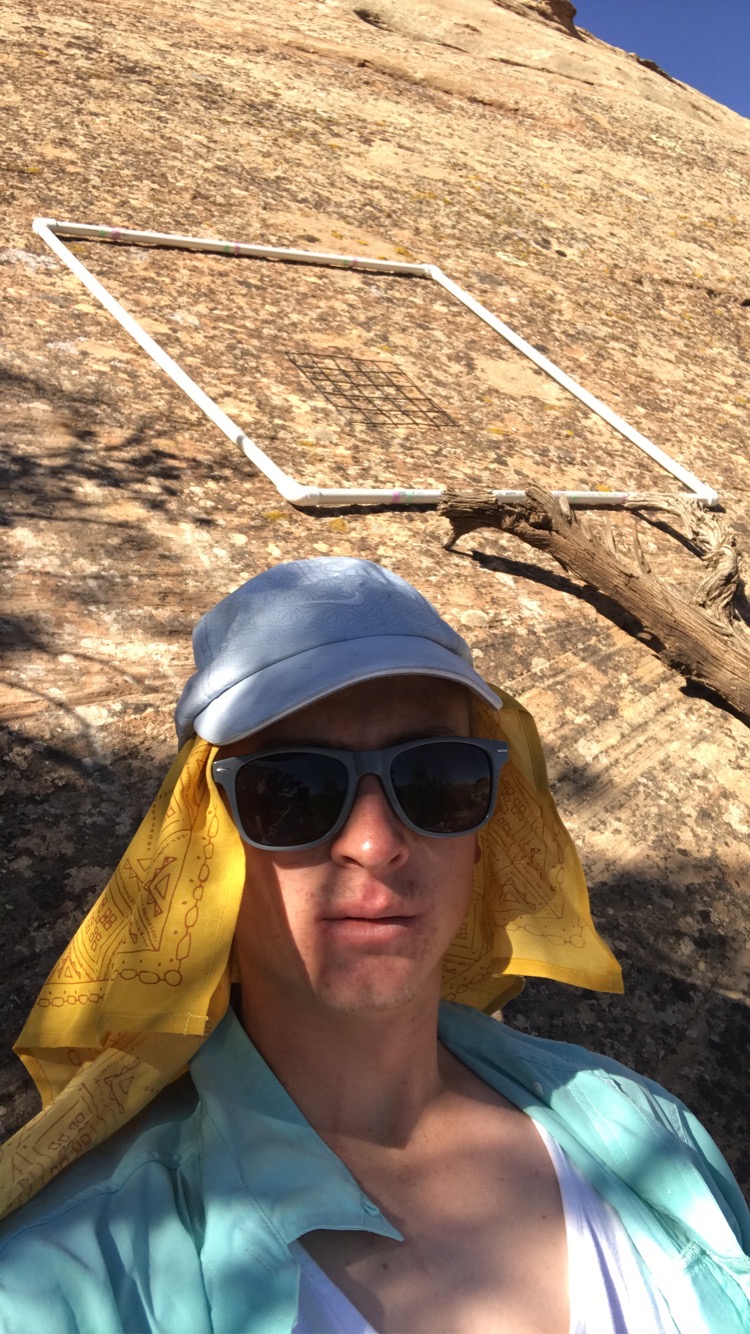Some information may be outdated.
Grand County High School student Brendan Moore was one of the first participants in Science Moab’s School to Science program, which pairs GCHS students with scientists for mentorship opportunities in the field and the lab. During this high-level internship, Brendan received guidance from his mentor, biological science technician Robin Reibold, along with biogeochemist Dr. Sasha Reed and supervisory biologist Dr. Erica Geiger, on how to develop his own research question and experimental method that he would use to investigate it. Brendan ultimately chose to study patterns of rock lichen development.
Science Moab: You were given the opportunity to pick your own internship topic, right?
Moore: Yes. Biogeochemistry is a focus at the lab, so I knew that I would be in the best hands with something around that topic. I was brainstorming for a few weeks on what I wanted to do. I spoke with Robin about what they do with soil lichen, and that opened up how little I knew about lichen. It’s something that you see all the time around Moab and I really hadn’t given it a second thought. Coming up with the experiment was way harder than I thought it would be—I had a broad question: Where do rock lichen grow best around the desert? I had to come up with a few variables, things that might affect lichen growth. Robin and some other scientists helped me think of what those might be—some things that were pretty key in that were rock type, what angle the lichen were growing at, and microclimate. I was mainly thinking about the diversity of lichen, how many different species were growing in a certain area, and the accumulation of lichen. It blew my mind looking into how many different combinations of cyanobacteria and fungi there could be, so I had to come up with a system to categorize those lichen.
Science Moab: So you narrowed down your questions. How did you go about collecting the data?
Moore: I came up with a hypothesis: I hypothesized that lichen would grow best at an angle of 40 degrees on north-facing slopes. We were thinking we’d collect data on around 180 sites, all on Navajo sandstone.
We used two PVC grids to collect data, using a method called an ocular estimate: Basically, we used the two grid tools to see how much lichen inhabit in one meter squared, and then a smaller 25-by-25 centimeter grid, so we were able to estimate how many lichens inhabit a certain square. That would give us the area of the lichen and percent covered. To categorize the different types of lichen, I created a photo log and named them—I ended up having about 13 different visual species of lichen. I was going out to that site to get three different angles within a range of 0 to 90, and then do north, south, east, and west. Each site took about 30 minutes. I was very new to the fieldwork side of things, so it took a couple of times to get good at ocularly estimating. But it was so much fun in the field.
Science Moab: So did you find out where lichen grow best? What other questions would you investigate if you had the time?
Moore: You could kind of tell when you’d go out and do field work and see a lot of lichen on the north slope, and the south slope was really bare. Actually looking at the data showed that a 20-degree angle range on north-facing slopes on this particular outcrop of Navajo sandstone had the most percent cover of lichen.
Robin was explaining to me in some of his experiments, he noticed lichens in the soil that had high nitrogen levels that corresponded with an organism’s ability to do nitrogen-fixing, which is when an organism takes nitrogen from the air, and then processes that, and that goes back into the soil. Nitrogen is something that a lot of plants need to grow, so that’s a very important quality that our cryptobiotic soil has. If I was to do a secondary experiment on this lichen to see if it was nitrogen fixing, maybe I could make correlations why certain lichens grow around a specific lichen because it might be turning nitrogen back into the rock that they use to grow. I’d also love to go in my original experiment and test different rock types and see how Kayenta sandstone fares versus Navajo.
Science Moab is a nonprofit dedicated to engaging community members and visitors with the science happening in Southeast Utah and the Colorado Plateau. To learn more and listen to the rest of this interview, visit www.sciencemoab.org/radio.
Appreciate the coverage? Help keep local news alive.
Chip in to support the Moab Sun News.





